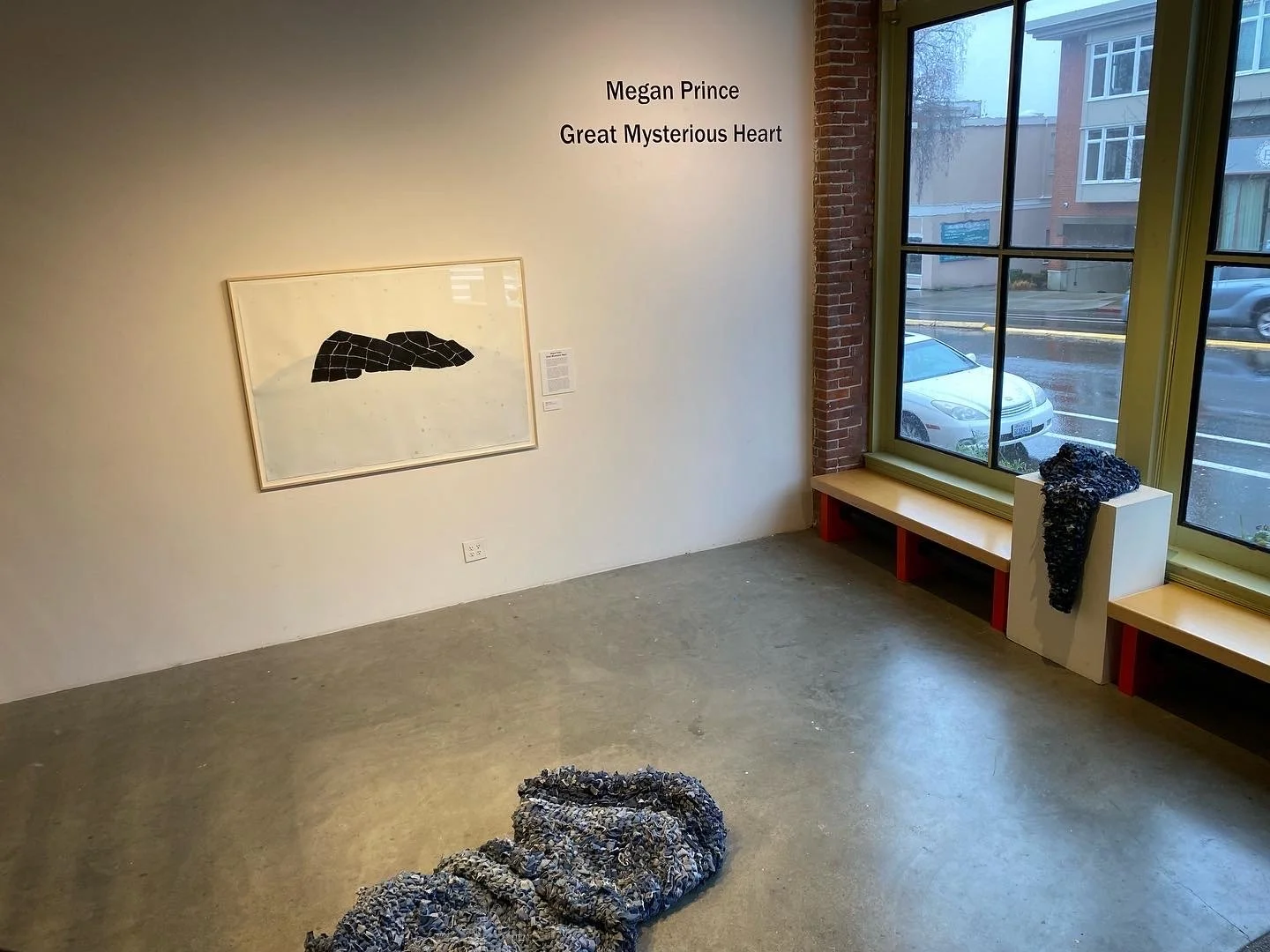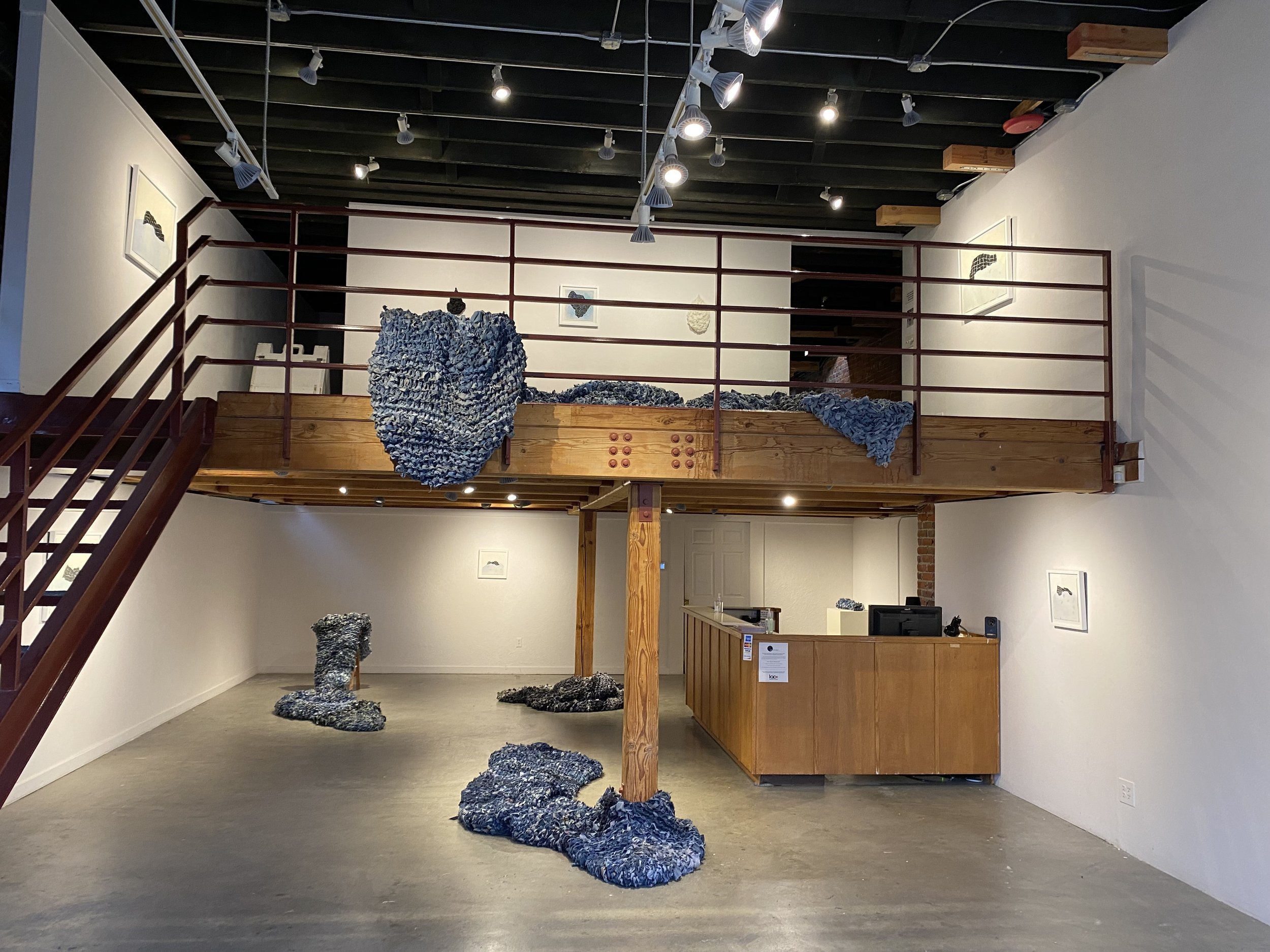With her work grounded in connection and relationships, Megan Prince is an interdisciplinary artist living and working in West Seattle. Beginning her artistic career in New York City, Prince has continued her practice in the Pacific Northwest by approaching no-waste methods of making with her body of work Jean Bodies and with her works on paper entitled Communities. Pivoting from the duties of motherhood and geographic changes, Prince is continuing to build upon her process orientated sculptures that breaches the concepts of global humanity, understanding, and amplifying muted voices.
This interview was conducted by Exhibitions Coordinator, Ellen McGivern and has been edited for rules of language and brevity.
Installation View of Great Mysterious Heart at the Kirkland Arts Center.
Ellen McGivern:
If you could just briefly introduce yourself to the readers of this interview.
Megan Prince:
My name is Megan Prince. I am an interdisciplinary visual artist here in Seattle, Washington. My work is mostly about relationships, relationships between people, personal relationships, but also larger relationships between people in their communities and how that word community can be so many different things. Communities is a collection of works on paper where I illustrate three levels of communities, and how there's a personal community that we are individually a part of, and then there's the larger community of the earth that we're part of. But then also, one more layer higher, the greater community of the universe that we all belong to.
McGivern:
One of my questions I wanted to ask was, why do you think your work focuses so greatly on communities or with our relationship with others? Can you elaborate on your interest?
Prince:
I've been interested in relationships for a very long time. You know, it probably started out as a baby concept, more like aesthetics, and relationships in aesthetics between dichotomies of large and small things. Ugly and beautiful things, finding buried separate ideas and trying to find where they meet. As I've gotten older, I've been really interested in more personal connection in communities and within my family. I am married and have three kids and every time I've added someone to my life that has deepened my relationship with the world, and my understanding of how the world works. In the last two years, people have been waking up. Relationships are political. Many people are not included or heard. I am really interested in finding and including everyone that wants to be included. I strongly believe that whether or not someone is in our daily life, once you know someone,they have an impact on you, and you have an impact on them, even if it's not someone that you had a good interaction with.
McGivern:
I know that you've also talked about social practice as a part of your work. And can you speak a little bit about how, like your interest in relationships kind of naturally progressed into being interested in more of a social practice?
Prince:
I'm really interested in social practice and art, because it's just one more way that we can include, and be connected to, others. It's one more way to form deeper community bonds between people. I think that's part of who I am, I'm really interested in sharing. I like to share, I don't really want to hold on to something to myself. I don't want to make it something that is precious. I don't want to hold it apart, I don't want my art to be separated from life, I want it to be part of life. And in life we don’t have that kind of control over what happens. The more I can include others in my work the more it will more fully represent relationships as they truly are in life. I think social practice is a very natural progression for my sculptures, in that they start with a donation from the person who first had them, wore them, and spent their time in the jeans. The wear marks and discoloration, rips, frays, mending and stains are all part of the sculptures. Taking something like a jean that has lived a full life and has evidence beat into it and then deciding to give it a new life honoring where it’s been. (There's a total Zero Waste aspect that I love also.) The personal invitation for donors to be part of my art and also creating something with materials usually put in a landfill. Each person/donation that is added to it, creates a deeper history and intertwines us. Another way social practice is evident in my fiber sculptures is through the installation process. These fiber sculptures are very malleable and will change shape with each installation. I am inviting each curator that works with me to show this series of my work to have full creative control over the installation of them, so long as it doesn’t affect the structure of the works. Curators are a voice we don’t usually hear too much of upfront in an exhibition. However, when you walk through Great Mysterious Heart you can see the curator, J.Gordon’s, thoughtful hand in the installation. Right when we started working on this show he was excited about the work, and when I told him he and his team would get to install the work they were really looking forward to it.
Detail Image of Jean Bodies sculpture, Because no one is listens to them they are not speaking the truth.
McGivern:
Could you kind of describe the process of the construction and overall shape of the Jean Bodies? Is it a weaving technique or knitting knots?
Prince:
My grandmother taught me how to knit when I was around 9 years old, about the same time I participated in 4H and learned about patterns and making clothes. I have always enjoyed working with textiles. When I first started processing jeans to use in my art it was clear I needed tools to help process material faster. Using an electric rotary cutter, I slice the donated jeans in my pattern and then tie the pairs together. I hand crochet the strip of jeans intuitively from there, dropping and adding stitches to create my vision for each piece. As I’ve been moving through creating these sculptures, I have begun sketching and planning out their shapes and forms they hold. I’ve always been really interested in biomorphic shapes, so the forms have a micro macro kind of relationship between them, almost like little cell amoebas that have been blown up, way out of proportion. You could think about them like a seashell that you find on the beach that's been washed by the waves.
McGivern: When we were in your studio we talked about inspiration and process. Do you sketch these forms before you create them or is it more intuitive or meditative?
Prince: I do a little bit of both, actually, it really depends. The first couple were probably more just intuitive or meditative. It was more forming them and developing them and creating this art object. But as I've been moving through them, I have done some development sketches that I've been working off of to create a specific shape.
McGivern: The no-waste aspect of your work really excites me. Do you use the hardware on denim?
Prince: That is something that I am actually exploring right now. Right now, the pattern that I'm going off of was not using the hardware. I actually cut it off at the hip, right where the waistband hits. I cut the zipper out and the tops of the pockets which usually have little metal pieces on them. The sculpture, Children Live Up to What We Believe in Them, I use the entirety of the jeans which was fun because children's clothes have a lot of elastic in them especially in pants. I think going forward, in the next piece I make, I probably will utilize all the hardware as I have been just recycling the top part of the jeans as waste. I don’t want there to be any waste though and I keep circling back to how not to have any waste. Recently, I’ve been thinking about making 2D sculptures with it. I don’t have an issue coming up with new ideas.
McGivern: Brainstorming is always a joy, completing those tasks always seem to be the tricky part. On that note, my final question is what is next for you? Where do you see your work progressing?
Prince: I've moved on to a 2D project called Love paintings,1000 paintings of Love, it is a concept my son and I came up with. I draw these fluid squares that mimic the jean body sculptures and they're kind of whimsical, but also kind of rigid, and they're fun. I'm working on lots of small ones. I'm planning to do 1,000 small ones and beginning to start doing some larger ones on paper. I really love working with color. I've started working on the next iteration of what the sculptures might look like with color.
Intallation View of Great Mysterious Heart at the Kirkland Arts Center.
Great Mysterious Heart is on view from January 7th through February 12th at Kirkland Arts Center. The gallery is open Wednesdays-Fridays, 12 - 6 PM and Saturdays 12 - 4 PM..
Artist Gallery Hours: 12-1pm Saturday, 1/15 and 1/29.
Artist Talk and Closing Reception: 6-8pm Friday, 2/11 (tentative)



